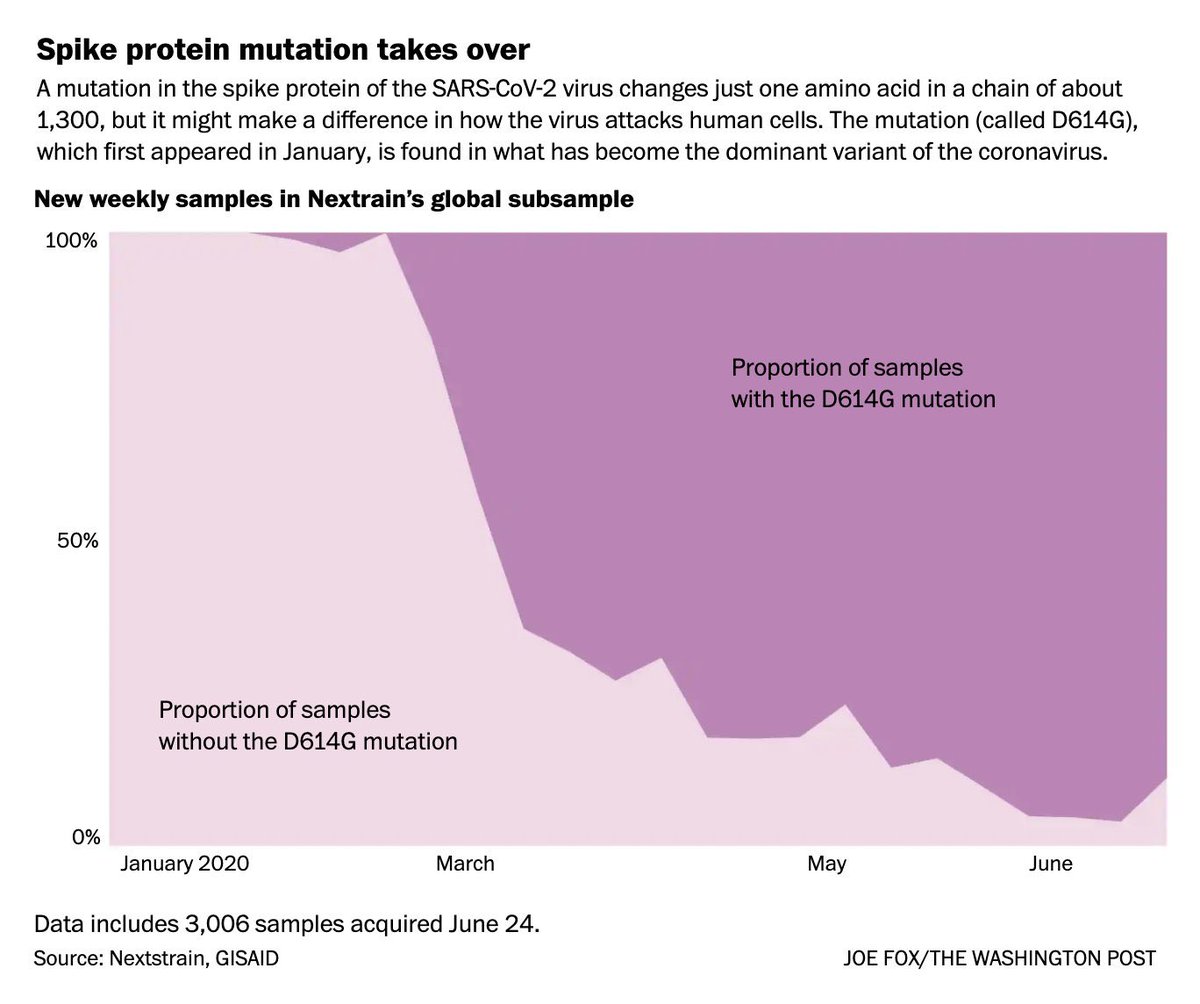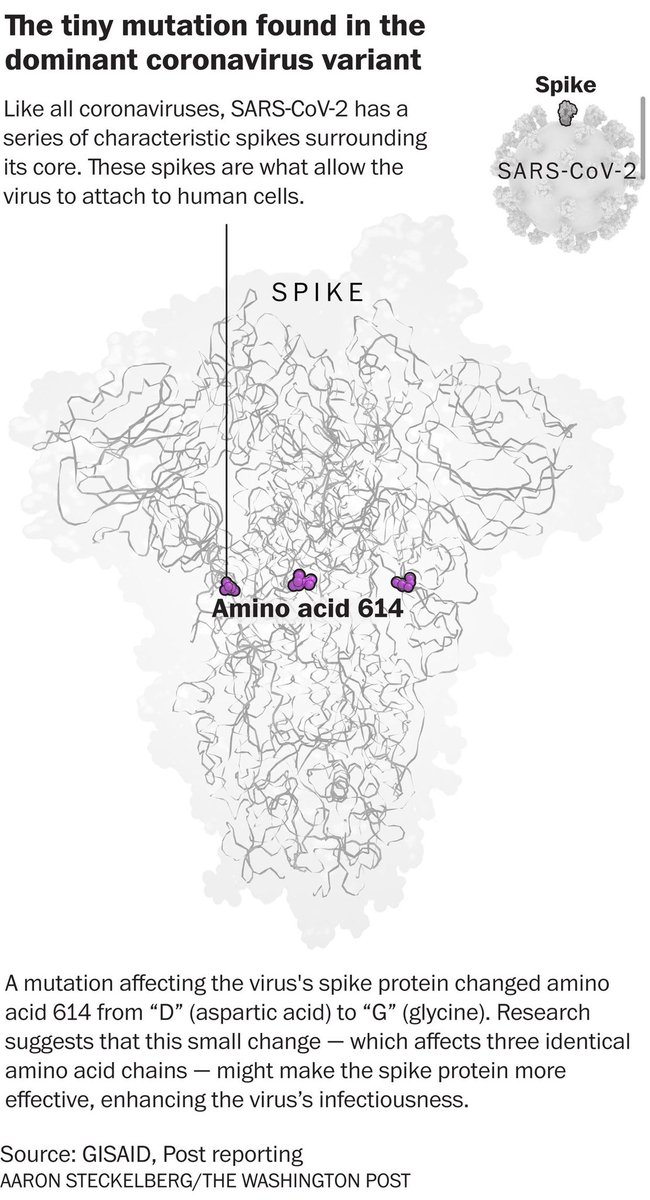Worrisome  https://abs.twimg.com/emoji/v2/... draggable="false" alt="🦠" title="Microbe" aria-label="Emoji: Microbe"> mutation: “At least four lab experiments suggest that the mutation makes the virus more infectious. Another study from Los Alamos National Lab finds that patients with the G variant actually have more virus in their bodies, i.e. more likely to spread it to others.
https://abs.twimg.com/emoji/v2/... draggable="false" alt="🦠" title="Microbe" aria-label="Emoji: Microbe"> mutation: “At least four lab experiments suggest that the mutation makes the virus more infectious. Another study from Los Alamos National Lab finds that patients with the G variant actually have more virus in their bodies, i.e. more likely to spread it to others.  https://abs.twimg.com/emoji/v2/... draggable="false" alt="🧵" title="Thread" aria-label="Emoji: Thread">
https://abs.twimg.com/emoji/v2/... draggable="false" alt="🧵" title="Thread" aria-label="Emoji: Thread">
2) A change in the virus was appearing again and again. This mutation, associated with outbreaks in Europe and New York, eventually took over the city. By May, it was found in 95 percent of all the genomes Ozer sequenced. https://www.washingtonpost.com/science/2020/06/29/coronavirus-mutation-science/">https://www.washingtonpost.com/science/2...
3) “At a glance, mutation seemed trivial. About 1,300 amino acids serve as building blocks for spike protein. In mutant virus, the genetic instructions for just one of those amino acids — # 614 — switched in new variant from a#”D” (aspartic acid) to “G” (glycine).”
4) “But the location was significant, because the switch occurred in the part of the genome that codes for the all-important “spike protein” — the protruding structure that gives coronavirus its crownlike profile and allows it to enter human cells the way a burglar picks a lock.”
5) “And its ubiquity is undeniable. Of the approximately 50,000 genomes of the new virus that researchers worldwide have uploaded to a shared database, about 70 percent carry the mutation, officially designated D614G but known more familiarly to scientists as “G.”
6) “The mutation doesn’t appear to make people sicker, but a number of scientists worry that it has made it more contagious.
“epidemiological study & our data together really explain why [G variant’s] spread in Europe and U.S. was really fast... This is not just accidental.”
“epidemiological study & our data together really explain why [G variant’s] spread in Europe and U.S. was really fast... This is not just accidental.”
7) “But there may be other explanations for the G variant’s dominance: biases in where genetic data are being collected, quirks of timing that gave the mutated virus an early foothold in susceptible populations.”
8) “The bottom line is, we haven’t seen anything definitive yet,” said Jeremy Luban, a virologist at the University of Massachusetts Medical School.u2029The scramble to unravel this mutation mystery embodies the challenges of science during the coronavirus pandemic.“
9) “The distinctive infectiousness of the G strain is so strong that scientists have been drawn to the mutation even when they weren’t looking for it.u2029Neville Sanjana, a geneticist at NYU, was trying to figure out which genes enable SARS-CoV-2 to infiltrate human cells...”
10) “But in experiments based on a gene sequence taken from an early case of the virus in Wuhan, he struggled to get that form of the virus to infect cells. Then the team switched to a model virus based on the G variant.u2029“We were shocked,” Sanjana said. “Voilà!”
11) “It was just this huge increase in viral transduction.” They repeated the experiment in many types of cells, and every time the variant was many times more infectious.”
12) “The spike protein for SARS-CoV-2 has two parts that don’t always hold together well. In version that arose in China, the outer part — which virus needs for human receptor — frequently broke off. Equipped with this faulty lock pick, it had a harder time invading host cells.”
13) “Studying both versions of the gene using a proxy virus in a Petri dish, Choe and her colleagues found that viruses with G variant had more spike proteins, and outer parts of those proteins were less likely to break off. This made virus ~10 times more infectious in the lab.”
14) “But New York team offers different explanation for why variant is so infectious. Whereas Choe’s study proposes that mutation made the spike protein more stable, Sanjana suggest that G variant is more efficient the process of invading & taking over its reproductive machinery”
15) “Luban, who has also been experimenting with the D614G mutation, has been drawn to a third possibility: His experiments suggest that the mutation allows the spike protein to change shape as it attaches to the ACE2 receptor, improving its ability to fuse to the host cell.”
16) “Although these experiments are compelling, they’re not conclusive, said Kristian Andersen, a Scripps virologist not involved in any of the studies. The scientists need to figure out why they’ve identified different mechanisms for the same effect.”
17) “Even then, Andersen said, it will be too soon to say that the G variant transmits faster among people.u2029Cell culture experiments have been wrong before. Early experiments with hydroxychloroquine hinted that it was effective at fighting the coronavirus in a petri dish.”
17) “The drug was touted a lot and FDA authorized it for emergency use in hospitalized covid-19 patients. But that authorization was withdrawn this month after evidence showed that the drug was “unlikely to be effective” against the virus and posed potential safety risks.”
19) “So far, the biggest study of transmission has come from Bette Korber, who built one of the world’s biggest viral genome databases for tracking HIV. In late April, she and colleagues released a draft of their work arguing that the mutation boosts transmission of the virus.”
20) “Analyzing sequences from more than two dozen regions across the world, they found that most places where the original virus was dominant before March were eventually taken over by the mutated version...”
21) “This switch was especially apparent in the United States: 96% of early sequences here belonged to the D variant, but by the end of March, almost 70% of sequences carried the G amino acid instead.”

 Read on Twitter
Read on Twitter mutation: “At least four lab experiments suggest that the mutation makes the virus more infectious. Another study from Los Alamos National Lab finds that patients with the G variant actually have more virus in their bodies, i.e. more likely to spread it to others. https://abs.twimg.com/emoji/v2/... draggable="false" alt="🧵" title="Thread" aria-label="Emoji: Thread">" title="Worrisome https://abs.twimg.com/emoji/v2/... draggable="false" alt="🦠" title="Microbe" aria-label="Emoji: Microbe"> mutation: “At least four lab experiments suggest that the mutation makes the virus more infectious. Another study from Los Alamos National Lab finds that patients with the G variant actually have more virus in their bodies, i.e. more likely to spread it to others. https://abs.twimg.com/emoji/v2/... draggable="false" alt="🧵" title="Thread" aria-label="Emoji: Thread">" class="img-responsive" style="max-width:100%;"/>
mutation: “At least four lab experiments suggest that the mutation makes the virus more infectious. Another study from Los Alamos National Lab finds that patients with the G variant actually have more virus in their bodies, i.e. more likely to spread it to others. https://abs.twimg.com/emoji/v2/... draggable="false" alt="🧵" title="Thread" aria-label="Emoji: Thread">" title="Worrisome https://abs.twimg.com/emoji/v2/... draggable="false" alt="🦠" title="Microbe" aria-label="Emoji: Microbe"> mutation: “At least four lab experiments suggest that the mutation makes the virus more infectious. Another study from Los Alamos National Lab finds that patients with the G variant actually have more virus in their bodies, i.e. more likely to spread it to others. https://abs.twimg.com/emoji/v2/... draggable="false" alt="🧵" title="Thread" aria-label="Emoji: Thread">" class="img-responsive" style="max-width:100%;"/>



